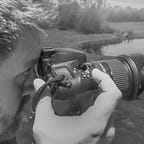Sometimes using high ISO is very handy. If you forgot your tripod or tripods aren’t allowed somewhere, using high ISO allows you to get the shot. Many photographers avoid high ISO though because they don’t want grainy photos. However, using Lightroom and Photoshop, here’s a quick trick to create beautiful, smooth photos even with high ISO settings.
Step 1. Take Several High ISO Photos
Using a high ISO setting, take several shots of the same thing with minimal camera movement between shots. You’ll use these shots to create one final smooth image.
In the example photo above, I took five shots at ISO 640. Because I took these shots in a busy ballroom in the Venetian Hotel in Las Vegas, I didn’t have a chance to setup a tripod and take a long exposure shot. These beautiful ceiling chandeliers were dimmed to provide ambiance. Using f/4.5 and 1/80 second, I was able to get crisp, in-focus shots even shooting handheld. However, the shots were rather grainy.
If you have a chance to use a tripod, you can still use this technique. Often you can catch a different character of light with higher ISO than you can with a long exposure. In other words, this isn’t just an emergency solution but should be a creative tool for your repertoire.
Step 2. Carefully Check Each Shot
Using the loupe or proofing tool in Adobe Lightroom (click on a portion of the photo in the main pane to enlarge it), check to make sure that each photo is as clear as possible. You will notice the grain but should be able to tell if you have camera movement in your shot. This technique can fix grain but camera movement will mess up the whole process. Get rid of your blurry shots.
On another occasion, I was shooting ISO 10000, f/2.8 and still needed 1/8 second exposure. As a result, out of the 13 images I took, four were blurry. Below, see how both sides are grainy, but the image on the right has a lot of camera movement and cannot be used. These are highly magnified with the loupe in Lightroom. I would not have noticed the camera movement blur without it.
Step 3. Make Adjustments (Optional)
At this point, before loading the images into Photoshop, some people like to make adjustments to the individual grainy source images. Personally, I rather make adjustments to one final image.
However, if you are set on making adjustments pre-merge, make sure to apply changes to all the images. To apply settings to multiple photos in Lightroom, select all the thumbnails, open the Settings menu, and click “Sync Settings…” That will open the box below. Check all the areas you’ve changed and click “Synchronize.”
Step 4. Open As Layers in Photoshop
From Lightroom, select all the high ISO images you’re going to merge. Under the Photo menu, select “Edit In” and then “Open as Layers in Photoshop…” If you’re using raw images, it will likely take a while for all the layers to finish loading in Photoshop.
Step 5. Align the Layers
In Photoshop, select all the layers (click the highest layer and then shift click the lowest layer). Then open the Edit menu and click “Auto-Align Layers…
In the Auto-Align Layers box, select “Auto” and click “OK.” Optionally, you can also perform lens correction here by removing vignette and geometric distortion.
Step 6. Convert to Smart Object
After Photoshop finishes aligning your layers, make sure your layers are still all selected. Right click (or control-click) somewhere on the mass of highlighted layers and select, “Convert to Smart Object.” By having multiple layers selected, you have created a Smart Object Stack.
Step 7. Set the Stack Mode
Under the Layer menu, select “Smart Objects,” “Stack Mode,” and “Median.” The Mean mode also works well. None of the other modes seems to provide useful results for this technique.
Step 8. Make Final Adjustments
At this point, your image should have far less grain. If necessary, you can use noise reduction in Photoshop or back in Lightroom. The borders of your image might be off because of all the aligning, so you will definitely want to crop that out. After the merge is when I begin any other edits such as adjusting exposure and color balance.
Congratulations! If you followed along, you’ve got a surprisingly smooth image using high ISO.
